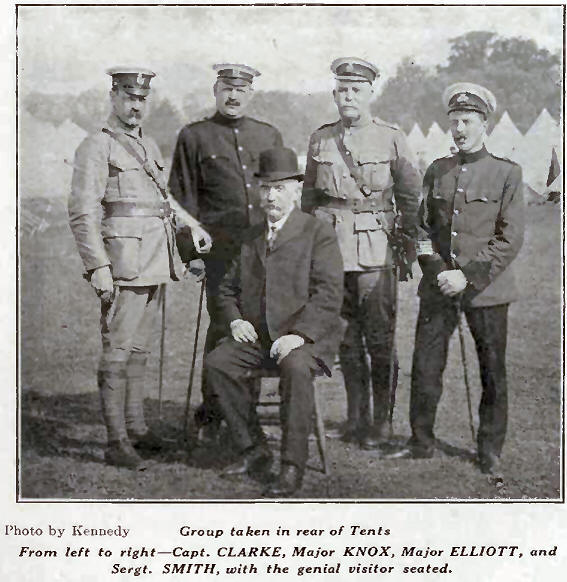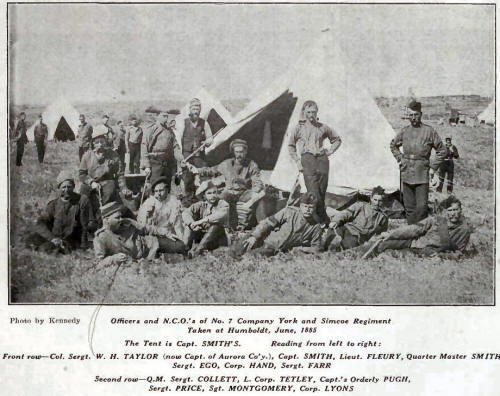|
Keeping Their Armor
Bright
AFTER the expectancy
and disappointment of 1866, the rural battalions settled down for a
score of years to the practice of the plain routine work of camp-going
regiments. Some excitement was caused it is true by the passing storm
clouds of the Fenian and Red River Troubles of 1870. In connection with
this latter the expedition of Sir Garnet Wolseley to the North West was
in one respect a model for future expeditions, in that instead of
throwing the brunt on single corps an effort was made to give a
representation in the experience and hazard of a campaign to officers
and men from various regiments.
Thus we note with effusive, if belated, gratitude that the 12th had a
representative in its Adjutant Peebles, who thus became an ensign in the
Ontario Battalion.

There were two of this
family in the expedition, the ensign and his father a ho, under the
designation of Control Officer, exercised the functions of a head
quartermaster for both battalions and was exceedingly popular with the
officers. This elder Peebles afterwards became police magistrate in
Winnipeg. We dilate upon this tremendous appointment of Ensign Peebles,
because outside of this and of the career of Capt. Vidal, who commanded
the Yorkville Company for a while and then went into the Permanent Corps
and rose to a high place, we are not aware of any officer of the 12th
who ever got anything.
Meanwhile during all the seventies and halfway into the eighties the
usual thing did not happen to the Militia of Canada. Their rifles,—of
the converted Snider Gas Pipe Model,—might be a little obsolescent, but
they were not rusted out. Their belts and knapsacks and ponderous
rib-erasing cartridge pouches might not be the last word in equipment,
but they were all present to be counted at the inspection. Thanks to the
stability of organization that arose from composing the regiments of
active companies and making them undergo periodical battalion and
brigade training there has since Confederation2 always been a
respectable body of militia with arms, uniforms, officers, sergeants and
some knowledge of the duties of military service.
The drill viewed with our more modern eyes may have been too highly
complicated, and more attention given than Avise to what General Wolfe
used to call “the one-two” and to movements which are now recognized as
niceties of ceremonial. Thus looking over our brigade and regimental
orders of June, 1884, we find that all the corps immediately upon
arrival at camp were required to mount their regimental guards; which
they evidently did With great solemn observance of parole and
countersign. Also Ave find that the wearing of the old corrosive
curb-chain strap of the helmet under the chin where it could do the most
harm was seemingly more important than musketry instruction.
But “twas a wholesome rigour in the main” and even in those days the
orders show that some latitude was allowed the rank and file. For do not
the camp orders of that same year allow bathing in the lake; with the
super-sage remark: “men going beyond their depth do so at their own
risk.”
And so along the years from 186(1 to 1885, the 12th went its way, having
had for its commanding officers in succession, Lieut.-Colonels Jan is,
Norris,3 Selby, Garden, and then Lieut.-Col. Wyndham, who was to take
the regiment into active service.
 |
